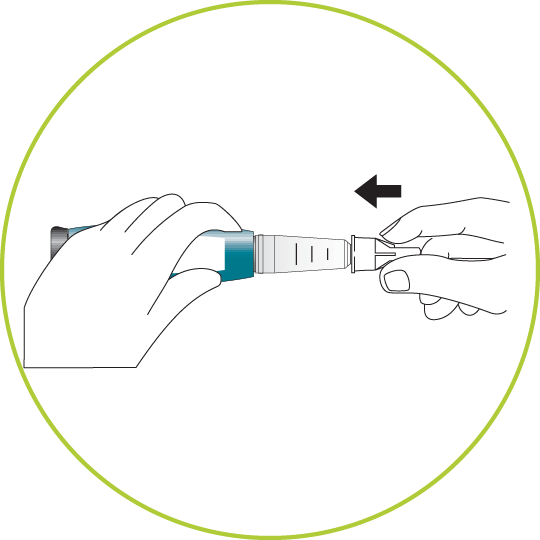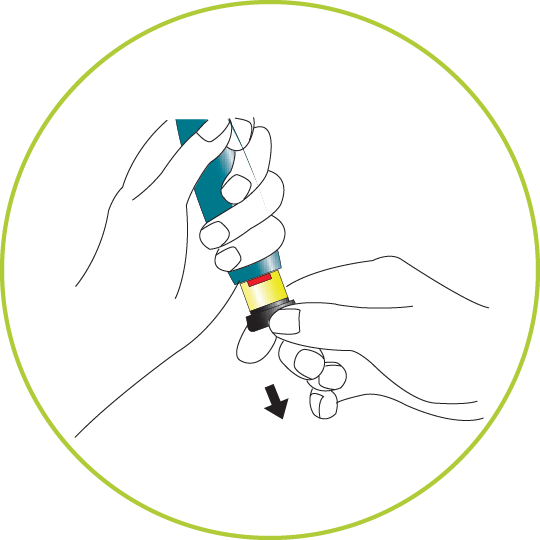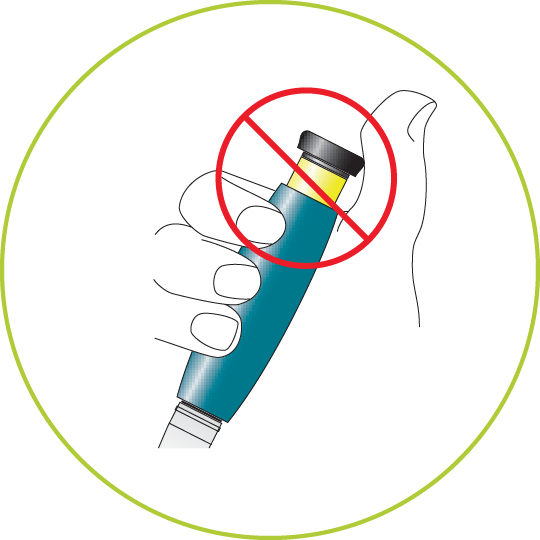
Learn how to use Teva’s Teriparatide Injection
How should you use Teva’s Teriparatide Injection?
- Make sure to read the User Manual included with your Teriparatide Injection delivery device.
- Use Teriparatide Injection exactly as your healthcare provider (HCP) tells you to. Your HCP will tell you how much Teriparatide Injection to use and when to use it.
- Your HCP should teach you how to use the Teriparatide Injection delivery device to give your injection the right way.
- Inject Teriparatide Injection 1 time each day in your thigh or abdomen (lower stomach area). Do not inject into a vein or a muscle. Talk to your HCP about how to rotate injection sites.
- The Teriparatide Injection delivery device has enough medicine for 28 days. It is set to give a 20-microgram dose of medicine each day. Do not inject all the medicine in the Teriparatide Injection delivery device at any one time.
- Do not transfer the medicine from the Teriparatide Injection delivery device to a syringe. This can result in taking the wrong dose of Teriparatide Injection. If you do not have pen needles to use with your Teriparatide Injection delivery device, talk with your HCP.
- Teriparatide Injection should look clear and colorless. Do not use Teriparatide Injection if it has particles in it, or if it is cloudy or colored.
- Inject Teriparatide Injection right away after you take the delivery device out of the refrigerator.
- After each use, safely remove the needle, recap the delivery device, and put it back in the refrigerator right away.
- When you inject the first few doses of Teriparatide Injection, make sure you are in a place where you can sit or lie down right away in case you feel dizzy or have an abnormal heartbeat after the injection.
- Do not take more than 1 injection in the same day.
- Do not share your Teriparatide Injection delivery device with other people.
- If you take more Teriparatide Injection than prescribed, call your HCP. If you take too much Teriparatide Injection, you may have nausea, vomiting, weakness, or dizziness.
- You should not use Teriparatide Injection for more than 2 years over your lifetime unless your HCP finds that you need longer treatment because you have a high chance of breaking your bones.
If your HCP recommends calcium and vitamin D supplements, you can take them at the same time you take Teriparatide Injection.
Important Information you should know about Teva’s Teriparatide Injection:
During drug testing, the medicine in Teriparatide Injection caused some rats to develop a bone cancer called osteosarcoma. Studies in people have not shown that Teriparatide Injection increases your chance of getting osteosarcoma. There is little information about the chance of getting osteosarcoma in patients using Teriparatide Injection beyond 2 years.
Watch this video to learn how to prepare and administer Teva's Teriparatide Injection.
Steps for using Teva’s Teriparatide Injection
Before using Teva’s Teriparatide Injection, be sure to read the User Manual provided with your delivery device. Your HCP will show you how to use the Teriparatide Injection delivery device. Wash your hands before every injection and prepare the injection site as your HCP instructed.
Get familiar with your Teriparatide Injection delivery device and the steps in the summary below.

Step 1: Pull off the blue cap
1

- Check the Teriparatide Injection delivery device label to make sure you have the right medicine and that it has not expired.
- Do not use if the Teriparatide Injection delivery device looks damaged, if the medicine in the cartridge is not clear and colorless, or if it has particles in it.
Step 2: Attach new needle
1

Pull off paper tab.
2

Push needle straight onto medicine cartridge.
3

Screw on needle clockwise until firmly attached.
4

Pull off large needle cover and save it.
Step 3: Set dose
1

Pull out black injection button until it stops.
If you cannot pull out the black injection button, see Troubleshooting.
2

Check to make sure red stripe shows.
3

Pull off small needle protector and throw away.
Step 4: Inject dose
1

Gently hold a fold of skin on your thigh or abdomen and insert needle straight into skin.
2

Push in black injection button until it stops. Hold it in and count to 5 slowly. You must wait until the count of 5 to make sure you receive the correct dose. Then pull the needle from skin.
Step 5 (IMPORTANT): Confirm dose after completing the injection
1

Correctly finished injection
Once the needle is removed from the skin, take your thumb off the black injection button. Check to make sure the black injection button is all the way in. If the yellow shaft does not show, you have finished the injection steps the right way.
2

Incorrectly finished injection
You should NOT see any of the yellow shaft. If you do and have already injected the medicine, do not inject yourself a second time on the same day. Instead, you MUST reset the Teriparatide Injection delivery device (see Troubleshooting).
Step 6: Remove needle
1

Put large needle cover on needle. Do not try to put the needle cover back on with your hands.
2

Unscrew the covered needle all the way by giving the large needle cover 3 to 5 counter-clockwise turns.
3

Pull off needle and throw away in a puncture-resistant container.
4

Push blue cap back on. Right after use, place Teriparatide Injection delivery device in the refrigerator.
If your Teriparatide Injection delivery device is not working as it should, please review the Troubleshooting Guide.
Important Safety Information
What is the most important information I should know about Teriparatide Injection?
Possible bone cancer. During drug testing, the medicine in Teriparatide Injection caused some rats to develop a bone cancer called osteosarcoma. Studies in people have not shown that Teriparatide Injection increases your chance of getting osteosarcoma. There is little information about the chance of getting osteosarcoma in patients using Teriparatide Injection beyond 2 years.
Who should not use Teriparatide Injection?
Do not use Teriparatide injection if you:
- are allergic to any of the ingredients in Teriparatide Injection. See the end of the Medication Guide for a complete list of the ingredients in Teriparatide Injection.
Symptoms of a serious allergic reaction of Teriparatide Injection may include swelling of the face, lips, tongue or throat that may cause difficulty in breathing or swallowing. Call your healthcare provider right away or get emergency medical help if you get any of these symptoms.
What should I tell my healthcare provider before using Teriparatide Injection?
Before you use Teriparatide Injection, tell your healthcare provider about all of your medical conditions, including if you:
- have a certain bone disease called Paget’s disease or other bone disease.
- have bone cancer or have had a history of bone cancer.
- are a young adult whose bones are still growing.
- have had radiation therapy.
- are affected with a condition that runs in your family that can increase your chance of getting cancer in your bones.
- have or have had too much calcium in your blood (hypercalcemia).
- have or have had a skin condition with painful sores or wounds caused by too much calcium.
- have or have had kidney stones.
- take medicines that contain digoxin.
- are pregnant or plan to become pregnant. It is not known if Teriparatide Injection will harm your unborn baby.
- are breastfeeding or plan to breastfeed. It is not known if Teriparatide passes into your breastmilk. You should not breastfeed while taking Teriparatide Injection.
Tell your healthcare provider about all the medicines you take including prescription and over-the-counter medicines, vitamins, and herbal supplements. Know the medicines you take. Keep a list of them to show your healthcare provider and pharmacist when you get a new medicine.
What are the possible side effects of Teriparatide Injection?
Teriparatide Injection may cause serious side effects including:
- See “What is the most important information I should know about Teriparatide Injection?”
- Bone cancer (osteosarcoma): Tell your healthcare provider right away if you have pain in your bones, pain in any areas of your body that does not go away, or any new or unusual lumps or swelling under your skin that is tender to touch.
- Increased calcium in your blood. Tell your healthcare provider if you have nausea, vomiting, constipation, low energy, or muscle weakness. These may be signs there is too much calcium in your blood.
- Worsening of your kidney stones. If you have or have had kidney stones your healthcare provider may check the calcium levels in your urine while you use Teriparatide Injection to see if there is worsening of this condition.
- Decrease in blood pressure when you change positions. Some people may feel dizzy, get a fast heartbeat, or feel light-headed right after the first few doses of Teriparatide Injection. This usually happens within 4 hours of taking Teriparatide Injection and goes away within a few hours. For the first few doses, give your injections of Teriparatide Injection in a place where you can sit or lie down right away if you get these symptoms. If your symptoms get worse or do not go away, contact your healthcare provider before you continue using Teriparatide Injection.
The most common side effects of Teriparatide Injection include pain, nausea, and joint aches. These are not all the possible side effects of Teriparatide Injection. For more information, ask your healthcare provider or pharmacist.
Call your doctor for medical advice about side effects. You are encouraged to report side effects of prescription drugs to the FDA. Visit www.fda.gov/medwatch or call 1-800-FDA-1088.
What is Teriparatide Injection?
Teriparatide Injection is a prescription medicine used to:
- treat postmenopausal women who have osteoporosis who are at high risk for having broken bones (fractures) or who cannot use other osteoporosis treatments. Teriparatide Injection can lessen the chance of broken bones (fractures) in the spine and other bones in postmenopausal women with osteoporosis.
- increase the bone mass in men with primary or hypogonadal osteoporosis who are at high risk for having broken bones (fractures) or who cannot use other osteoporosis treatments.
- treat both men and women with osteoporosis due to use of glucocorticoid medicines, such as prednisone, for several months, who are at high risk for having broken bones (fractures) or who cannot use other osteoporosis treatments.
It is not known if Teriparatide Injection is safe and effective in children. Teriparatide Injection should not be used in children and young adults whose bones are still growing.
Please read the Medication Guide in the full Prescribing Information.